Photograph by Ing-On Vibulbhan-Watts
I went to Thailand to visit my family for two months, from July and August 2017. I did not visit home since 2006. I was glad to see my family. I enjoyed seeing all new development in Bangkok and loved eating authentic Thai food, especially Thai fruits.
I had a chance to visit my home town, Lopburi, where I was raised when I was young, before we moved to Bangkok. I traveled to Ayutthaya to see the ruins of temples that were burned by Burmese soldiers, when the Burmese wanted to take over Thailand, The Burmese–Siamese War (1765–1767). Ayutthaya was one of the former capitals of Thailand before moved to, Thonburi and then Bangkok. I also traveled to, Chiang Mai, located in the Northern part of Thailand. Chiang Mai is the second largest and second most popular city of Thailand.
John, my husband came to Thailand in August. He joined me traveling to different part of Thailand. I had a good time taking videos and photographs wherever I traveled around Bangkok and other part of Thailand. I hope the viewers of my website will enjoy the photographs that I present in these projects.
Ing-On Vibulbhan-Watts, Thursday, October 26, 2017
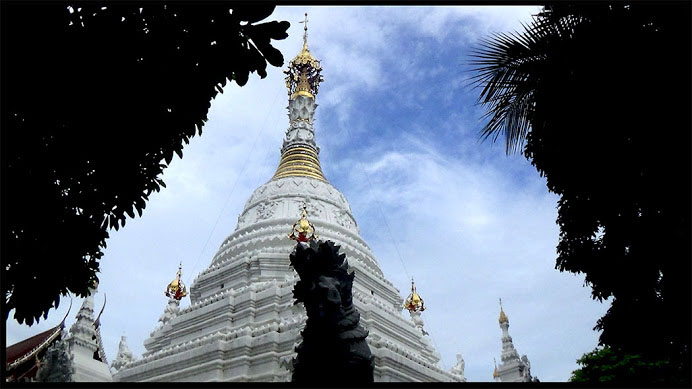 Wat Mahawan, Chiang Mai
Wat Mahawan, Chiang Mai
Welcome To My Beloved Country, Thailand
Photograph by Ing-On Vibulbhan-Watts
Chiang Mai has over 300 Buddhist temples (“wat” in Thai).[29] These include:
• Wat Phrathat Doi Suthep, the city’s most famous temple, stands on Doi Suthep, a hill to the north-west of the city. The temple dates from 1383.
• Wat Chiang Man, the oldest temple in Chiang Mai, dating from the 13th century.[1]:209 King Mengrai lived here during the construction of the city. This temple houses two important and venerated Buddha figures, the marble Phra Sila and the crystal Phra Satang Man.
• Wat Phra Singh is within the city walls, dates from 1345, and offers an example of classic Northern Thai-style architecture. It houses the Phra Singh Buddha, a highly venerated figure brought here many years ago from Chiang Rai.[30]
• Wat Chedi Luang was founded in 1401 and is dominated by a large Lanna style chedi, which took many years to finish. An earthquake damaged the chedi in the 16th century and only two-thirds of it remains.[31]
• Wat Ku Tao in the city’s Chang Phuak District dates from (at least) the 13th century and is distinguished by an unusual alms-bowl-shaped stupa thought to contain the ashes of King Nawratha Minsaw, Chiang Mai’s first Burmese ruler.[32]
• Wat Chet Yot is on the outskirts of the city. Built in 1455, the temple hosted the Eighth World Buddhist Council in 1977.
• Wiang Kum Kam is at the site of an old city on the southern outskirts of Chiang Mai. King Mengrai lived there for ten years before the founding of Chiang Mai. The site includes many ruined temples.
• Wat Umong is a forest and cave wat in the foothills west of the city, near Chiang Mai University. Wat U-Mong is known for its “fasting Buddha”, representing the Buddha at the end of his long and fruitless fast prior to gaining enlightenment.
• Wat RamPoeng (Tapotaram), near Wat U-Mong, is known for its meditation center (Northern Insight Meditation Center). The temple teaches the traditional vipassana technique and students stay from 10 days to more than a month as they try to meditate at least 10 hours a day. Wat RamPoeng houses the largest collection of Tipitaka, the complete Theravada canon, in several Northern dialects.[33]
• Wat Suan Dok is a 14th-century temple just west of the old city wall. It was built by the king for a revered monk visiting from Sukhothai for a rainy season retreat. The temple is also the site of Mahachulalongkorn Rajavidyalaya Buddhist University, where monks pursue their studies.[34]
• “First Church” was founded in 1868 by the Laos Mission of the Rev. Daniel and Mrs. Sophia McGilvary. Chiang Mai has about 20 Christian churches[35] Chiang Mai is the seat of the Roman Catholic Diocese of Chiang Mai at Sacred Heart Cathedral.
• Muslim traders have traveled to north Thailand for many centuries, and a small settled presence has existed in Chiang Mai from at least the middle of the 19th century.[36] The city has mosques identified with Chinese or Chin Haw Muslims as well as Muslims of Bengali, Pathan, and Malay descent. In 2011, there were 16 mosques in the city.[37]
• Two gurdwaras (Sikh Temples), Siri Guru Singh Sabha and Namdhari,[38] serve the city’s Sikh community.[38]
• The Hindu temple Devi Mandir serves the Hindu community.[38]
For more information please visit the following link:
https://en.wikipedia.org/wiki/Chiang_Mai
 Wat Mahawan, Chiang Mai
Wat Mahawan, Chiang Mai
Burmese style chedi
Behind the principal viharn stands the attractive chedi, ornamented with very detailed stucco work. The Burmese style chedi is enclosed by a low crenellated wall, at each of its corners stands a large guardian Chinthe.
The bell sits on a base of several square tiers of receding size and an octagonal tier. The top consists of a spire and a very ornate golden hti.
At the center of each side of the chedi is a niche with a small stairway leading to it, the bodies of a fearsome creature extending over the balustrades. Enshrined in each niche is a standing statue of the Buddha, flanked by celestial beings.
For more information please visit the following link:
https://www.renown-travel.com/temples/wat-mahawan.html
Wat Mahawan, Chiang Mai
Burmese style viharn
In the North-West corner of the temple complex stands a large Burmese style viharn. The brick building was constructed by a wealthy Burmese teak trader towards the end of the 19th century. The hall enshrines a large seated Burmese style Buddha image.
For more information please visit the following link:
https://www.renown-travel.com/temples/wat-mahawan.html
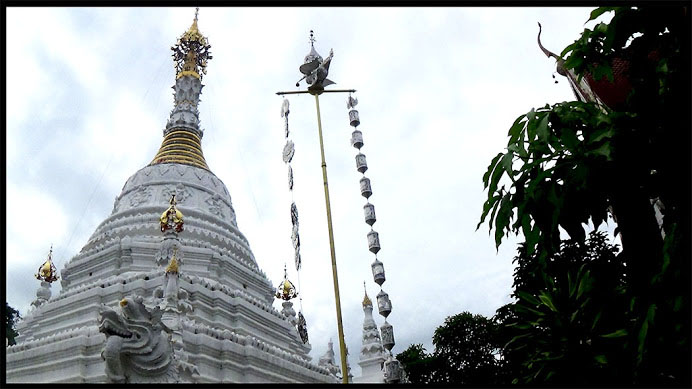 Wat Mahawan, Chiang Mai
Wat Mahawan, Chiang Mai
How to get to the Wat Mahawan
The temple is found about 300 meters East of Tha Phae gate outside the old walled town center of Chiang Mai. It is located on Tha Phae road just past Tha Phae Soi 5, opposite the Wat Cheatawan.
For more information please visit the following link:
https://www.renown-travel.com/temples/wat-mahawan.html
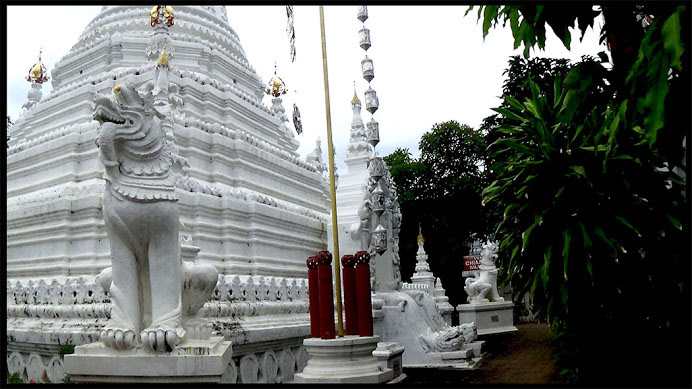 Wat Mahawan, Chiang Mai
Wat Mahawan, Chiang Mai
Founding date unknown
Principal viharn 1865
Location: Tha Phae road just past Tha Phae Soi 5, Chiang Mai
For more information please visit the following link:
https://www.renown-travel.com/temples/wat-mahawan.html
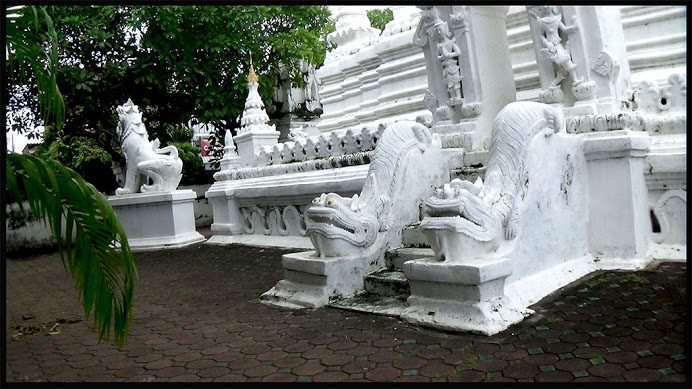 Wat Mahawan, Chiang Mai
Wat Mahawan, Chiang Mai
Welcome To My Beloved Country, Thailand
Photograph by Ing-On Vibulbhan-Watts
Wat Mahawan, Chiang Mai
Just outside the old walled town center of Chiang Mai near Tha Phae gate is the Wat Mahawan, an attractive temple with both Lanna and Burmese style buildings and many sculptures of mythical creatures. Several gate houses in the surrounding wall are guarded by Chinthe, mythological lions often found in Burmese temples.
The temple comprises of a Lanna style viharn and ubosot, a large Burmese style chedi, a Ho Trai and a large Burmese style brick viharn.
For more information please visit the following link:
https://www.renown-travel.com/temples/wat-mahawan.html
 Wat Mahawan, Chiang Mai
Wat Mahawan, Chiang Mai
Lanna style viharn
The main viharn with its imposing multi tiered roof was build in 1865. The ends of the barge boards are adorned with mythological Naga serpents. At the roofs top are chofah, a decorative element in the shape of a thin bird, representing Garuda, the mount of the Hindu God Vishnu.
Flanking the stairs to the viharn’s entrance are two large, white Chinthe guarding the hall. The Lanna style wooden panels on the front gable are adorned with very detailed carvings of deities and flower motifs in gold on a red background.
Large gold lacquered red columns support the roof. Seated on a pedestal to the back of the viharn is the principal Buddha image in subduing Mara posture surrounded by several smaller images.
For more information please visit the following link:
https://www.renown-travel.com/temples/wat-mahawan.html
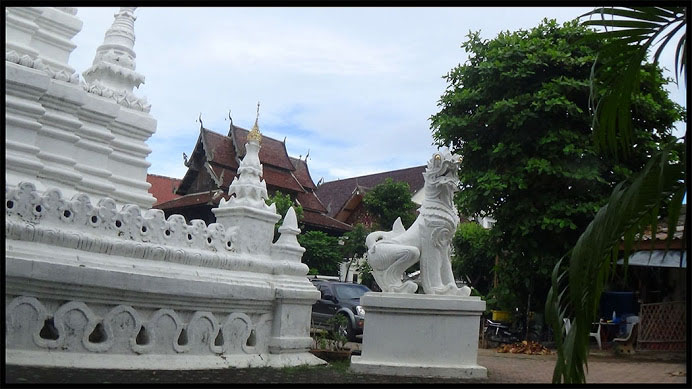 Wat Mahawan, Chiang Mai
Wat Mahawan, Chiang Mai
Welcome To My Beloved Country, Thailand
Photograph by Ing-On Vibulbhan-Watts
Wat Mahawan, Chiang Mai
Ubosot: Next to the principal viharn stands the ubosot, the hall where novices are ordained into monkhood. Access to the small bot is through an entrance gate adorned with very detailed stuccoed decorations of mythological beings and Lanna flower motifs.
The Lanna style building is fitted with a two-tiered roof; stylized Nagas adorn the ends of the elaborately carved white barge boards. The gable is embellished with golden Lanna flower motifs, while the door contains golden flower motifs on a red background.
For more information please visit the following link:
https://www.renown-travel.com/temples/wat-mahawan.html
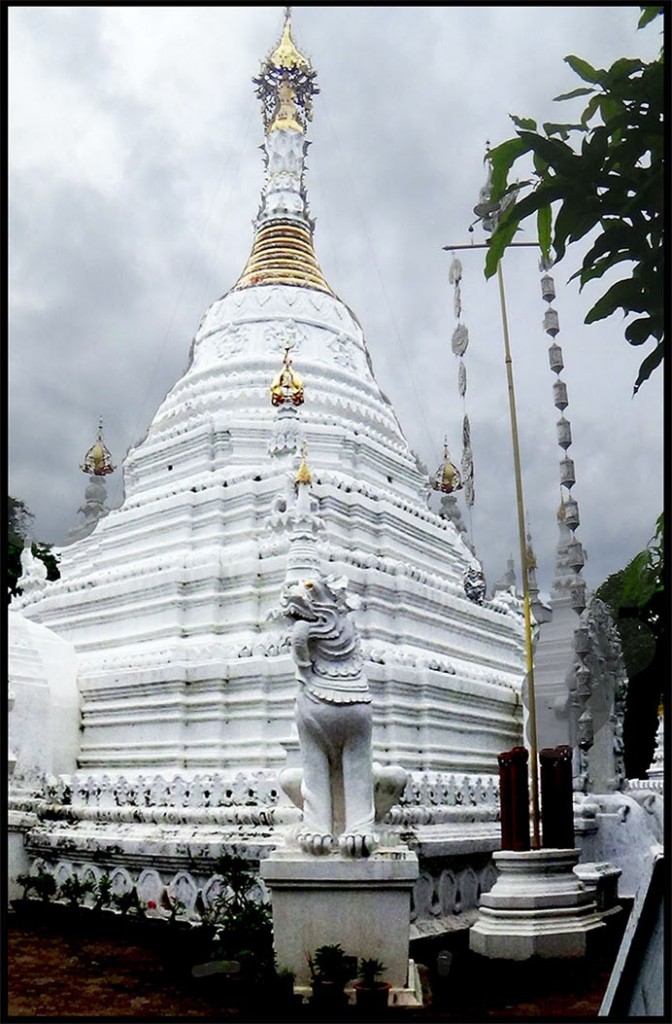 Wat Mahawan, Chiang Mai, Thailand
Wat Mahawan, Chiang Mai, Thailand
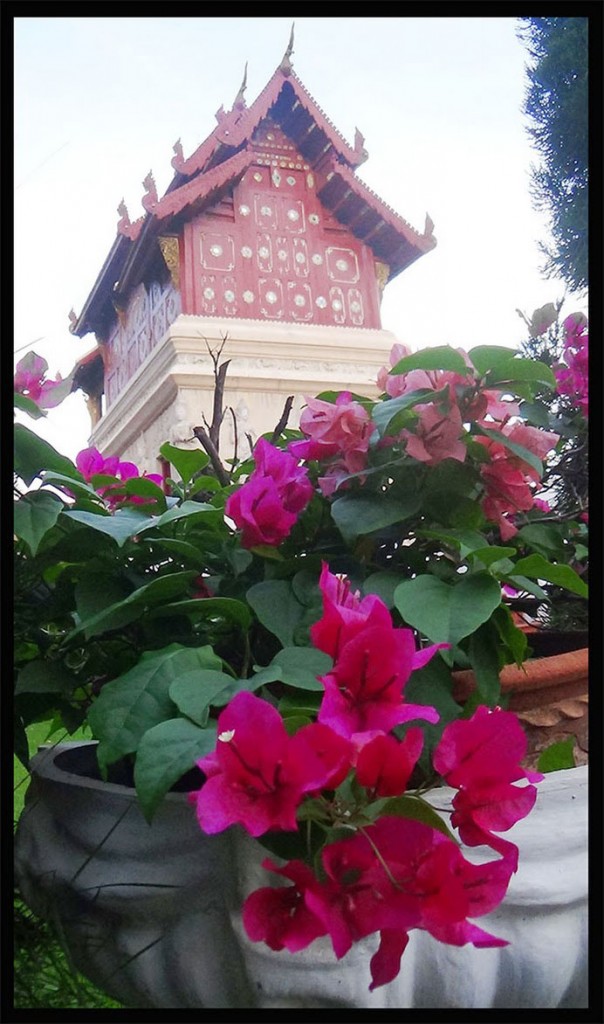 Ho Trai (temple library), Wat Phra Singh, Chiang Mai, Thailand
Ho Trai (temple library), Wat Phra Singh, Chiang Mai, Thailand
Ho Trai – the temple library is another prime example of classical Lanna architecture and it is one of the most beautiful temple libraries in Thailand. The guards, flanking the stairs, consist of lions emerging from the mouths of a Makara, a mythical water creature. This combination is rarely seen elsewhere.
Ho Trai scripture library: The Ho Trai, a dark teak wooden structure wit a multi-tiered roof has been turned into the residence of the Wat Mahawan’s abbot. The building was originally used as the temple scripture library where copies of the Tripitaka, the Buddhist teachings traditionally written on dried palm leaves are kept.
For more information please visit the following link:
https://www.renown-travel.com/temples/wat-mahawan.html
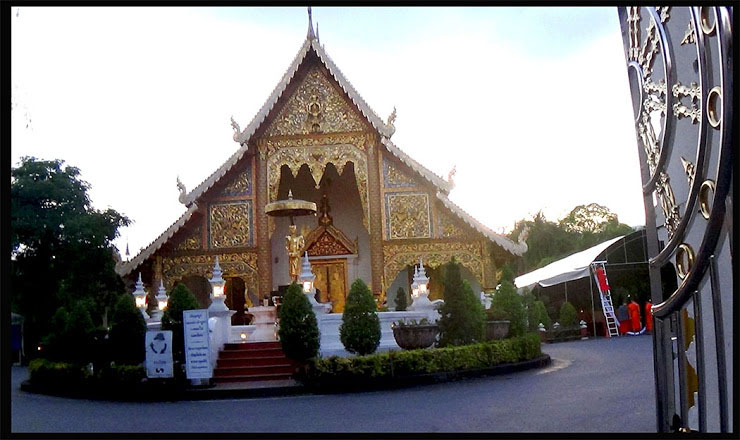 Wat Phra Singh, Chiang Mai, Thailand
Wat Phra Singh, Chiang Mai, Thailand
Welcome To My Beloved Country, Thailand
Photograph by Ing-On Vibulbhan-Watts
History: Construction on Wat Phra Singh began in 1345 when King Phayu,[2]:226–227 the fifth king of the Mangrai dynasty, had a chedi built to house the ashes of his father King Kham Fu. A wihan and several other buildings were added a few years later and the resulting complex was named Wat Lichiang Phra. When, in 1367, the statue of Phra Buddha Singh was brought to the temple, the temple complex received its present name. During restoration works in 1925, three funerary urns were discovered inside a small chedi. It was assumed that these contained royal ashes. The urns have since been lost. From 1578 to 1774 the Burmese ruled Lanna and in this period the temple was abandoned and came under serious disrepair. It was only when King Kawila assumed the throne as King of Chiang Mai in 1782, that the temple was restored. King Kawila had the ubosot built and the chedi enlarged. Later successors restored the Wihan Lai Kham and the elegant Ho Trai (temple library).
The whole temple complex underwent extensive renovations under the famous monk Khru Ba Srivichai during the 1920s. Many of the buildings were again restored in 2002.
For more information please visit the following link:
https://en.wikipedia.org/wiki/Wat_Phra_Singh
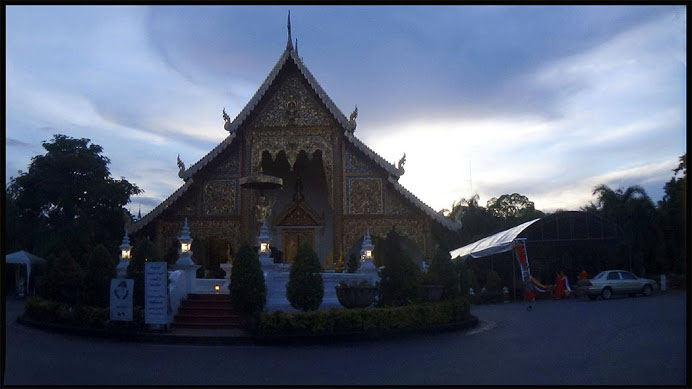 Wat Phra Singh, Chiang Mai, Thailand
Wat Phra Singh, Chiang Mai, Thailand
Notability: The temple houses an important Buddha statue: the Phra Buddha Sihing which gives the temple its name. The origins of this statue are unknown but, according to legend, it was based on the lion of Shakya, a statue since lost which used to be housed in the Mahabodhi Temple of Bodh Gaya (India). The Phra Buddha Sihing statue is supposed to have been brought, via Ceylon (present day Sri Lanka), to Ligor (present day Nakhon Si Thammarat) and, from there, via Ayutthaya, to Chiang Mai.
There are two more Buddha statues in Thailand which are claimed to be the Phra Buddha Sihing: one is housed in Wat Phra Mahathat in the city of Nakhon Si Thammarat and another in the Bangkok National Museum.[1]:227,369
It is alleged that the head of the statue had been stolen in 1922. The possibility remains that the present statue (or maybe only the head) is a copy.
Every year, during the Songkran festival, the statue is taken from wihan Lai Kham and carried through the streets of Chiang Mai in a religious procession during which the spectators honour the statue by sprinkling water over it.
For more information please visit the following link:
https://en.wikipedia.org/wiki/Wat_Phra_Singh
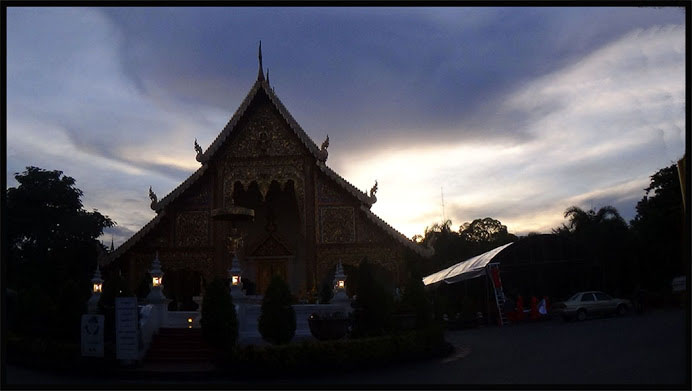 Wat Phra Singh, Chiang Mai, Thailand
Wat Phra Singh, Chiang Mai, Thailand
Wat Phra Singh (full name: Wat Phra Singh Woramahaviharn; RTGS: Wat Phra Sing Wora Maha Wihan; (pronunciation); Lanna: ) is a Buddhist temple (Thai language: Wat) in Chiang Mai, Northern Thailand. King Ananda Mahidol (Rama VIII), the older brother of the late King Bhumibol Adulyadej (Rama IX), bestowed on it the status of Royal temple of the first grade in 1935.
For more information please visit the following link:
https://en.wikipedia.org/wiki/Wat_Phra_Singh
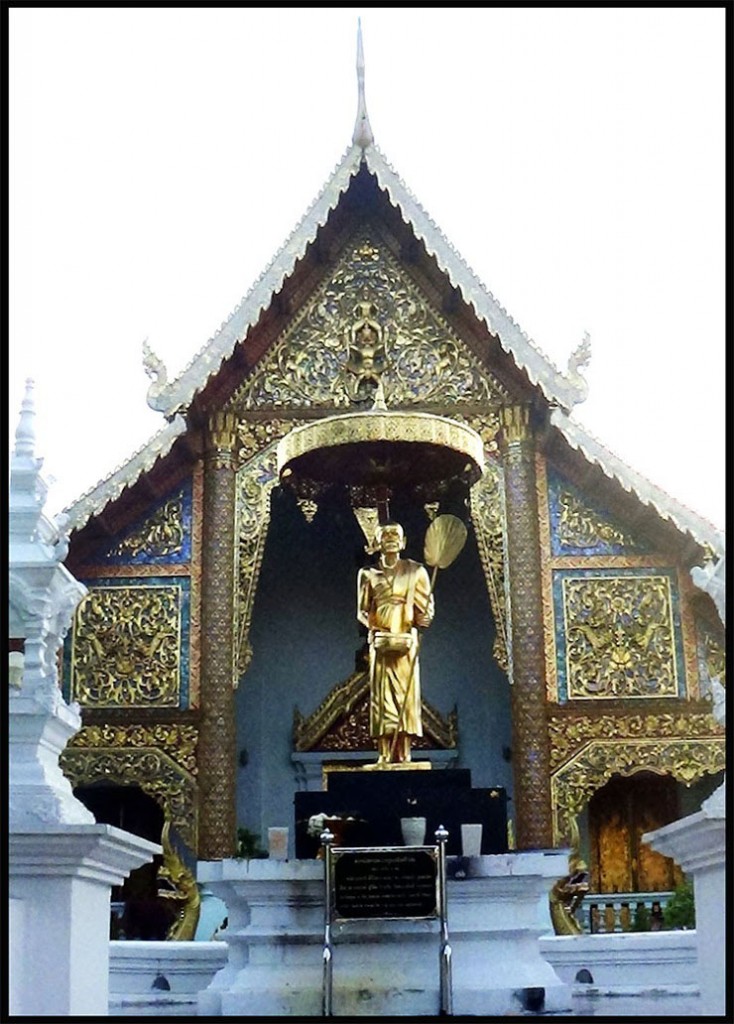 Wat Phra Singh, Chiang Mai, Thailand
Wat Phra Singh, Chiang Mai, Thailand
Wihan Luang – the original wihan was replaced by the present building in 1925.
Wihan Lai Kham – this wihan is the main attraction of the complex. It was built in 1345 to house the Phra Buddha Singh statue and it is a prime example of classical Lanna architecture. The murals of the wihan are also highly remarkable. The murals on the left show the history of Songthong and on the right the history of Suwanna Hongse.
Ubosot – built in 1806, it contains two entrances: a south entrance for monks and a north entrance for nuns. It is as such a song sangha ubosot (‘song’ meaning ‘two’ in Thai). The building houses a mondop with the Phrachaotongtip Buddha statue, a smaller version of the Phra Buddha Sihing and it is therefore also known as Phrasingha noi (‘noi’ meaning ‘small’ in Thai). The northern end of the wihan, near the entrance for the nuns, contains a copy of the Emerald Buddha.
For more information please visit the following link:
https://en.wikipedia.org/wiki/Wat_Phra_Singh
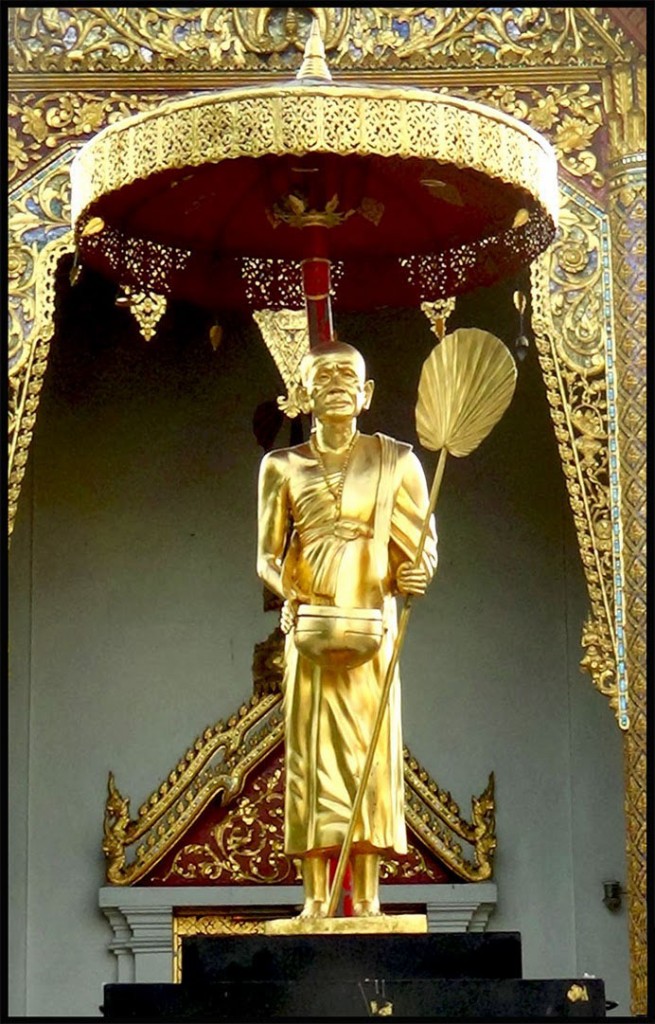 Wat Phra Singh, Chiang Mai, Thailand
Wat Phra Singh, Chiang Mai, Thailand
The Phrathatluang – each side of the square base of the main chedi of the complex features the front half of an elephant emerging from it. After it was built in 1345, the chedi was enlarged several times.
The Kulai chedi – this small square based chedi, built as a pagoda with five tiered roofs by King Mueangkaeo (1495-1525), is connected to Wihan Lai Kham by a short tunnel which is not opened to visitors. When the chedi was restored under King Dharmalanka (1813-1822), a golden box containing ancient relics was found. After the works were completed, the box and its contents were placed once more inside the chedi.
For more information please visit the following link:
https://en.wikipedia.org/wiki/Wat_Phra_Singh
 Wat Phra Singh, Chiang Mai, Thailand
Wat Phra Singh, Chiang Mai, Thailand
Welcome To My Beloved Country, Thailand
Photograph by Ing-On Vibulbhan-Watts
Wat Phra Singh is located in the western part of the old city centre of Chiang Mai, which is contained within the city walls and moat. The main entrance is guarded by Singhs (lions). Wat Pra Singh is situated at the end of the main street (Rachadamnoen road) of Chiang Mai. The road runs east from the temple, via Tapae Gate, to the Ping River.
Name: Phra Singh is an abbreviated form of Phra-Put-Tha-Shi-Hing and does not refer to the word Singh (“lion”).
For more information please visit the following link:
https://en.wikipedia.org/wiki/Wat_Phra_Singh
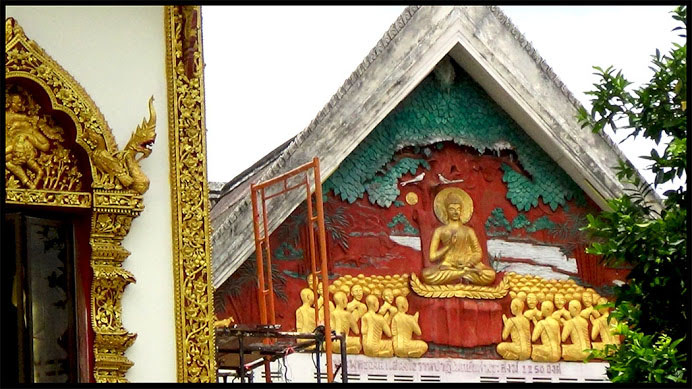 Wat Buppharam, Chiang Mai, Thailand
Wat Buppharam, Chiang Mai, Thailand
Welcome To My Beloved Country, Thailand
Photograph by Ing-On Vibulbhan-Watts
Wat Buppharam pronounced [wát bùp.p???.r??m]) is a Buddhist temple in Chiang Mai, Thailand. Founded in 1497 by King Mueang Kaeo,[1] the temple was where Kawila began a ritual circumambulation of Chiang Mai to reoccupy it after two centuries of Burmese rule.[2] Most of the temple buildings date to the late 1800s.[2] The temple is also known for its Burmese-style chedi, which was rebuilt in 1958, and a Lanna-style ordination hall made from teak and glass inlay mosaic, built in 1819.[3]
For more information please visit the following link:
https://en.wikipedia.org/wiki/Wat_Buppharam,_Chiang_Mai
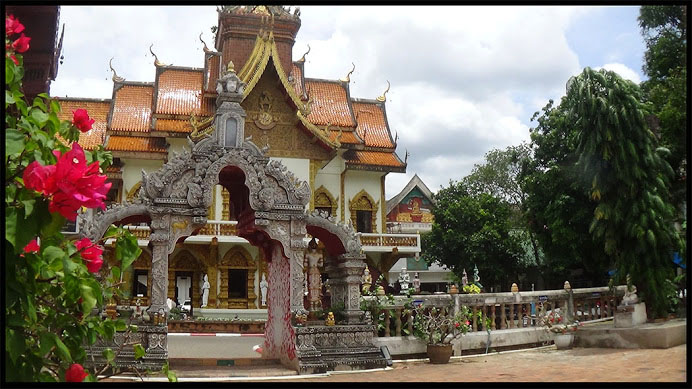 Wat Buppharam, Chiang Mai, Thailand
Wat Buppharam, Chiang Mai, Thailand
Wat Bua Pharam is an ancient temple at Phaya Muk Kaeng, King of Lanna No. 12, Meng Rai. Please make it in 2039 was restored in 2362 by the prince of Dharma, please build a small temple. The Lanna Art Wood There is a glazed stucco glass. Carved wood carving The temple is large. Gable, Burmese carvings, is a statue of a handsome bronze Buddha statue weighing 400 kilograms, and a Buddha image. Chiang Saen is casted with bronze on the left and right side of the temple. The Buddha image of teak lap width of 1 watts is about 400 years old, however.
The importance of the temples of all the worshipers is that this was once the abode of the Patriarch of Passover. And it is enshrined the Lord Buddha’s relics of Lord Buddha. There will be a tradition of worshiping Buddha relics on the lunar calendar month six (north central month 4) around February every year.
Google Translate for Business:Translator ToolkitWebsite Translator
For more information please visit the following link:
https://thai.tourismthailand.org/%E0%B8%AA%E0%B8%96%E0%B8%B2%E0%B8%99%E0%B8%97%E0%B8%B5%E0%B9%88%E0%B8%97%E0%B9%88%E0%B8%AD%E0%B8%87%E0%B9%80%E0%B8%97%E0%B8%B5%E0%B9%88%E0%B8%A2%E0%B8%A7/%E0%B8%A7%E0%B8%B1%E0%B8%94%E0%B8%9A%E0%B8%B8%E0%B8%9E%E0%B8%9E%E0%B8%B2%E0%B8%A3%E0%B8%B2%E0%B8%A1–131
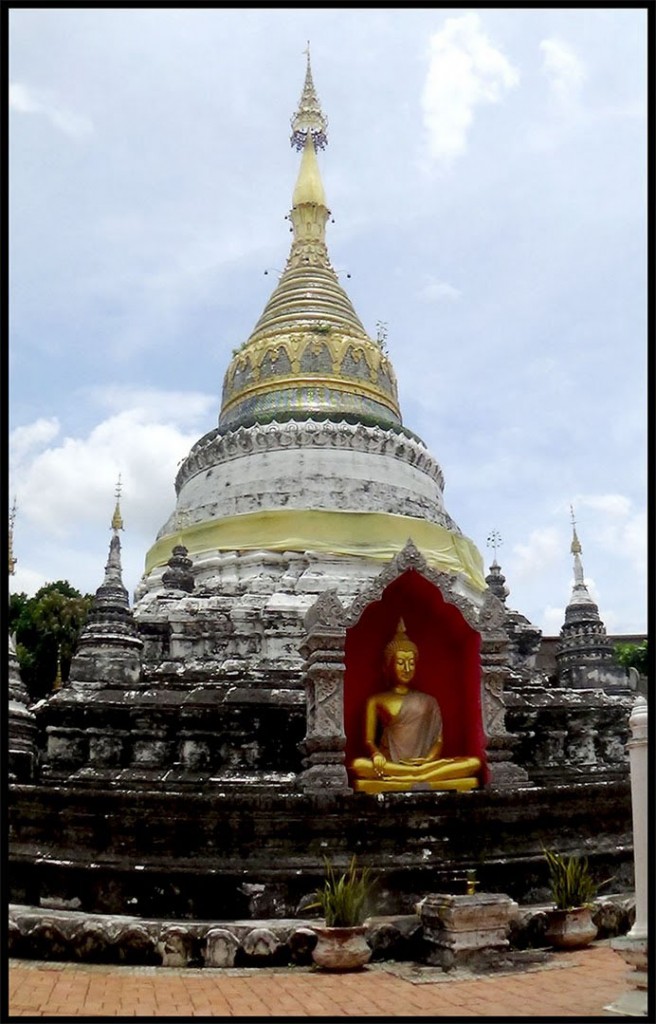
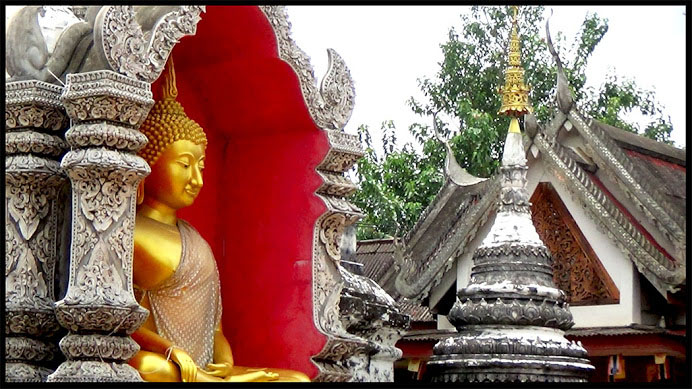 Wat Buppharam, Chiang Mai, Thailand
Wat Buppharam, Chiang Mai, Thailand
Welcome To My Beloved Country, Thailand
Photograph by Ing-On Vibulbhan-Watts
Location: Located at 143 Thapae Road, opposite Wat Sa Fang, Chang Klan District, Muang District, Chiang Mai Province. For that trip. Drive along the Super Highway. Lampang – Chiang Mai Before Chiang Mai. Turn left at the intersection Luang Luang. Then drive straight ahead. Until the bridge over Nawarat. Then drive straight for about 800 meters, Buppam temple located on the left hand side.
For more information please visit the following link:
https://en.wikipedia.org/wiki/Wat_Buppharam,_Chiang_Mai

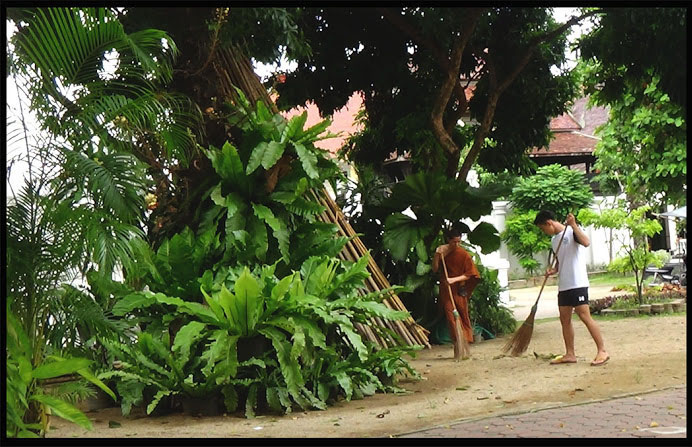

Leave a Reply